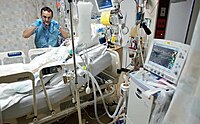
Photo from wikipedia
Intensive care unit-acquired weakness (ICUAW) is common and prolongs the duration of mechanical ventilation and ICU length of stay and is also a leading cause of physical restriction up to… Click to show full abstract
Intensive care unit-acquired weakness (ICUAW) is common and prolongs the duration of mechanical ventilation and ICU length of stay and is also a leading cause of physical restriction up to five years later. Developing diagnostic tools that allow early identification and risk stratification in all critically ill patients is vital. Ultrasound is a cheap, reproducible and noninvasive imaging modality that can be used to assess multiple muscle groups. It has advantages over other imaging techniques that entail risks of radiation as well as the logistical concerns of moving critically ill patients. Ultrasound muscle indices can be monitored over time and may serve as predictors for ventilatory weaning and long-term outcomes. The diaphragm is frequently perturbed during critical illness, specifically when mechanical ventilation is initiated. Diaphragm thickness and excursion have been shown to support extubation strategy with the former serving as a marker of inspiratory effort in the absence of more specialist tests. The techniques are reproducible with appropriate training and practice and have been applied in clinical trials. Peripheral skeletal muscle ultrasound has been the subject of intense research in ICU-acquired muscle weakness. The technique has also been found to be reproducible and can serve as a surrogate marker to current volitional and non-volitional tests in the assessment of muscle ICUAW. This article outlines the application of musculoskeletal ultrasound and its role in the early recognition of ICUAW in three distinct muscle groups: (1) diaphragm (2) rectus femoris and introduces the potential of (3) parasternal muscles.
Journal Title: Ultraschall in der Medizin
Year Published: 2020
Link to full text (if available)
Share on Social Media: Sign Up to like & get
recommendations!